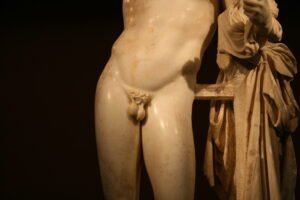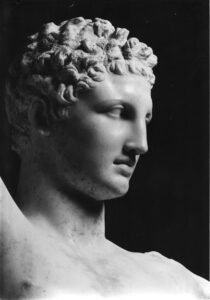“Hermes Carrying the Infant Dionysus,” marble statue by Praxiteles, c. 330 BC
Considered among the greatest works of ancient greek art creations, a symbol of beauty and aesthetics.
The statue is a work of the renowned Athenian sculptor Praxiteles who achieved to convert a large piece of Parian marble into a masterpiece of harmony and eurhythmy.
Hermes, Zeus’ son and one of the Olympian gods, is holding the infant Dionysos in his left arm. Acting as the divine messenger of his father, Hermes is about to deliver his little brother Dionysos, the god of wine and amusement, to the nymphs in Thebes.
The god is resting on a trunk of a tree, exposing his athletic figure, a real model of male beauty. In his raised, right arm, now missing, Hermes was probably holding a bunch of grapes, a symbol of Dionysos, who turns his attention in this direction.
The statue was discovered in the Temple of Hera during the early phase of the excavations in Olympia, in 1877
It dates to the second half of the 4th century B.C. and exudes the naturalistic features that prevailed during that period.





